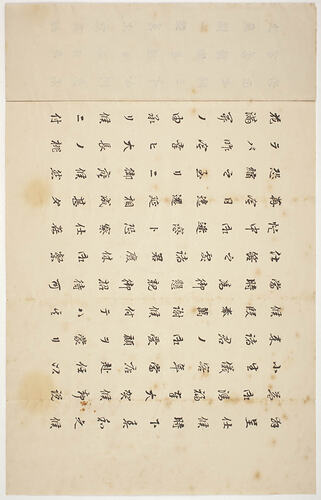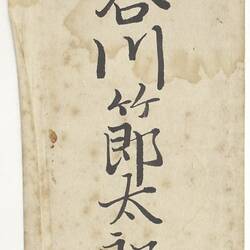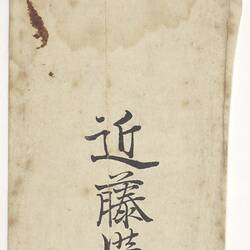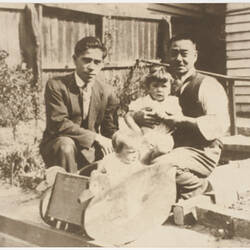Summary
Letter addressed to Setsutaro Hasegawa. The formal placement of the letter and care with which it was written suggest that it maybe an official letter. Setsutaro migrated to Australia from Japan in 1897 at the age of 26, just four years before the introduction of the Immigration Restriction Act which severely limited migration to Australia from countries in Asia. He established a laundry business in Geelong and by 1911 he had married an Australian-born woman and had three children.
In 1941 Setsutaro was arrested as an enemy alien and sent to Tatura internment camp in northern Victoria. Released early in 1943 due to his age and poor health, unlike most Japanese interns he was not deported to Japan after the War. Setsutaro remained in Geelong for the rest of his life and died in 1952.
Physical Description
Long format cream paper sheet with formal spaced Japanese characters filling the page. There are nine folds. There is also an envelope with Japanese characters in black ink on the front and the back.
Significance
The Hasegawa collection enables the exploration of a number of important historical themes relating to migration, working life, and wartime internment in Victoria. Late nineteenth century and early to mid twentieth century Japanese migration and settlement experiences are little represented in the museum's collections and this collection of clothing, documents, personal items and photographs helps to redress.
More Information
-
Collecting Areas
-
Acquisition Information
Donation from Andrew Hasegawa, Andrew Hasegawa, 08 Feb 2008
-
Addressed To
-
Other Association (See Comments)
Japan
Sent from Japan. -
Inscriptions
Extensive Japanese text.
-
Classification
Migration, Settlement - cultural & social life, Correspondence
-
Category
-
Discipline
-
Type of item
-
Overall Dimensions - Folded
296 mm (Width), 190 mm (Height)
Dimensions taken with four folds of letter exposed and remainder still in folded form; Fully open approx: 530L x 188H
-
References
5 family photographs (need originals from donor to scan)
-
Keywords
Correspondence, Japanese Communities, Japanese Culture, Japanese Immigration





